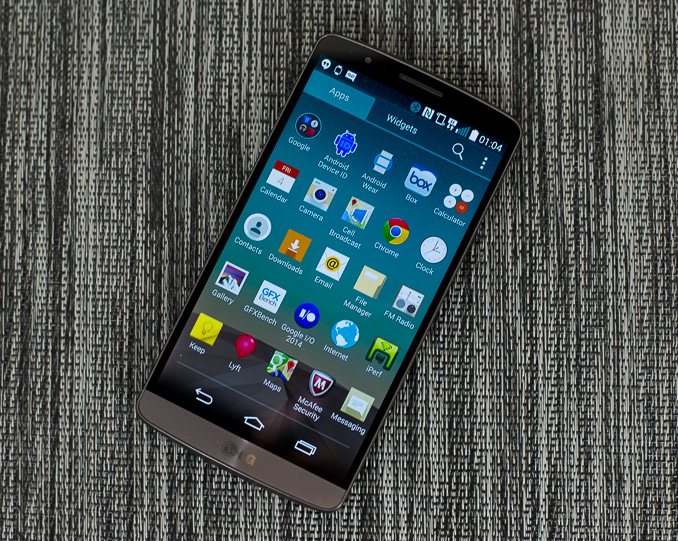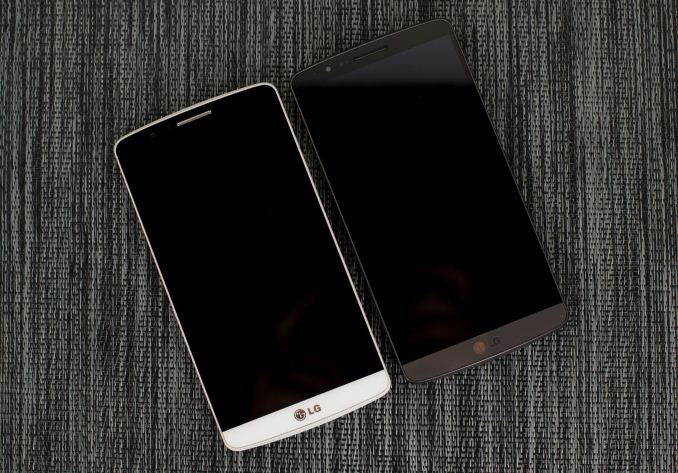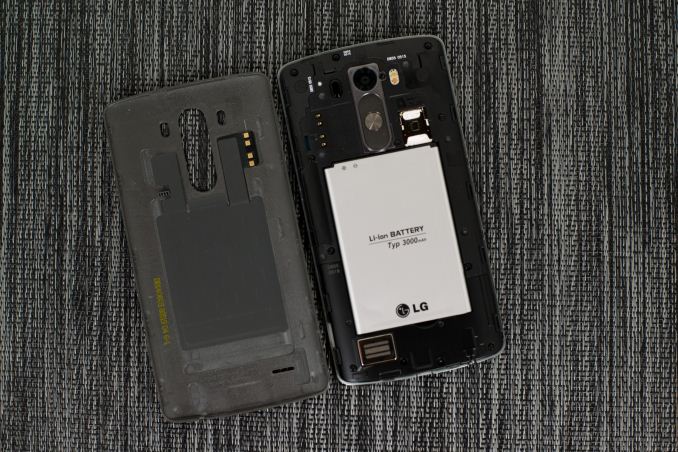The LG G3 Review
by Joshua Ho & Anand Lal Shimpi on July 4, 2014 5:00 AM EST- Posted in
- Smartphones
- LG
- Mobile
- Laptops
- G3

While the enthusiast segment is no stranger to LG smartphones, for the most part LG hasn’t received nearly the amount of attention that Samsung has. At first, it doesn’t make much sense. After all, LG is almost as big as Samsung. Both are chaebols, with enormous resources and power that few other companies have. Starting from the Optimus G, it seems that LG has shipped some of the best hardware in the industry, leveraging all the branches of the company from LG Innotek to LG Display to make a product that was easily equal to or better than the competition at the time.
One of the real issues that LG faced was a credibility gap. After the Optimus 2X and 4X HD, LG simply lacked credibility amongst the enthusiast audience. Without this audience and without the marketing push that other OEMs had, LG phones simply didn’t sell. Fortunately, things have gotten better since those days. The G2 brought significant attention to LG phones, and if anything, LG has been the sleeping giant in the industry. LG’s displays have been some of the best in the industry, and as an Android OEM they’ve consistently executed well on hardware. The immense popularity of the LG-made Nexus 4 and 5, even amongst mainstream consumers is surprising, especially because they were supposed to be developer devices.
Hardware
This leads us to the LG G3, which is now available in Korea and ready to be sold internationally. LG now faces the difficult task of succeeding the G2, one of the best phones of 2013. To find out whether they’ve made a worthy successor, we start with industrial and material design. When you first pick up the G3, it’s obvious that LG wanted to make a phone with the look and feel of brushed aluminum. To this end, LG has definitely done a good job. Although the polycarbonate back feels much warmer in the hand, the texture is good, and in practice even after extended use I never felt like the phone was grimy. It’s good to see that most of these OEMs are moving away from glossy finishes. The back cover is also removable, which allows for a removable battery and microSD slot. The front of the display is almost unchanged from last year, with extremely small bezels all around to reduce wasted space. The one change to the front of the phone is a band of color around the bottom that matches the color of the back.
Around the sides, the port layout remains nearly identical. The top has the IR Tx/Rx ports, the bottom has the 3.5mm jack and a microUSB port in the USB 2.0 shape. LG has also added a beveled edge from the display to the sides, which emphasizes the curved nature of the back. On the back of the phone, one can see the camera with the IR rangefinder and LED flash to the sides. The volume and power buttons are directly below the camera. The volume rocker is relatively flat compared to the protruding power button, which also has a noticeably different texture to distinguish the two from each other. The single, 1W speaker is towards the bottom.
Outside of these basic button and port placements, the hardware itself is high-end. The key differentiation points in this case are the camera system, QHD display, and the high-power speaker. I’ve put the rest of the basic specs in the table below.
| LG G3 | |
| SoC | MSM8974AC 2.45 GHz Snapdragon 801 |
| RAM/NAND | 3 GB LPDDR3, 32GB NAND + microSD |
| Display | 5.5” 1440p IPS LCD |
| Network | 2G / 3G / 4G LTE (Qualcomm MDM9x25 UE Category 4 LTE) |
| Dimensions | 146.3 x 74.6 x 8.9mm, 149 grams |
| Camera | 13MP rear camera, 1.12 µm pixels, 1/3.06" CMOS size, F/2.4. 2.1MP F/2.0 FFC |
| Battery | 3000 mAh (11.4 Whr) |
| OS | Android 4.4.2 with LG UI |
| Connectivity | 802.11a/b/g/n/ac + BT 4.0, USB2.0, GPS/GNSS, MHL, DLNA, NFC |
| SIM Size | MicroSIM |
While the spec sheet gives an idea of what to expect from the G3’s size, it’s surprisingly small for a 5.5” display size device. Unfortunately, this doesn’t make the G3 easy to use with one hand. While using the One (M8) and Galaxy S5 with one hand is uncomfortable, the G3 is almost impossible to use with one hand. Trying to tap something on the left side of the phone when using it with the right hand is difficult, and trying to reach for something on the top left of the display is almost impossible. While the division between phone and phablet is relatively clear in my mind, the G3 is in the line between both. I don’t object to the phablet formfactor, but this is supposed to be a phone, not a phablet. In addition, because the G3 has such thin bezels, it's very easy to accidentally activate the touch panel unintentionally while trying to stretch for one area of the display.
Other than the size, I definitely like what LG has done here. The design of the phone is understated and classy, even if it’s a bit off-putting that LG is trying to make plastic feel like metal. The back buttons are a non-issue, even without KnockOn/Off and KnockCode, and the curved back is great for ergonomics. However, I question the wisdom of moving to a removable battery/back cover in this case, as it means that there’s no stacked battery that we saw in the LG G2 and reduces volumetric efficiency. LG has included a curved battery in the G3, although in practice the curve isn't as aggressive as the one we've seen on the G2.













174 Comments
View All Comments
SlyFoxHD - Friday, July 4, 2014 - link
LG G3 battery can withstand 6 hours of screen-on time,on full brightness.And watch
Suck it up.
http://www.phonearena.com/news/First-improvised-LG...
Flunk - Friday, July 4, 2014 - link
What you're saying isn't really compatible with what's said in this article, if it dims the screen even when you set the brightness manually how can you possibly test at 100% brightness?Troll fail.
mahalie - Friday, July 4, 2014 - link
It only dims the screen slightly if the phone is in danger of overheating, so it's possible to test the screen at 100% brightness.Alexey291 - Sunday, July 6, 2014 - link
So its 100% but its not full brightness - way to twist words /sighfokka - Friday, July 4, 2014 - link
full brightness*david4041 - Friday, July 4, 2014 - link
No.. If LG G3 had the same resolution as the GS5 or M8, with the bigger screen it would not have been as sharp (ppi). What LG managed to do was build a phone with a significantly bigger screen AND a higher ppi. And since the G3 has a thinner bevel, it isn't much bigger than the GS5 and M8.Battery life? From what I've read, the phone should last all day. That's all one really needs. Charge the phone at night, charge it while you're at your desk, charge it in the car, buy an extra battery, buy a battery pack.
peterfares - Friday, July 4, 2014 - link
It would have been plenty sharp with an RGB 5.5" screen. Look at the Note 3, that has a PenTile 1080p 5.7" screen.soldier45 - Sunday, July 6, 2014 - link
Haters going to hate innovation and moving forward with tech.flatrock - Tuesday, July 8, 2014 - link
The G3 is a showcase for what LG is capable of, so spec-sheet oneupmanship is to be expected. I would like to see 1080p screens show up on some slightly smaller and more affordable devices. Or LG can just keep making the G2 for a while. The G2 is a great phone and is still a high end phone even this long after the initial release. If the G3 didn't pull some spec-sheet oneupmanship the reviews would just be complaining about a lack of compelling differences from the G2. I guess it's the price LG pays for doing the G2 so well.barleyguy - Tuesday, July 8, 2014 - link
One place I can think of where the resolution would be a benefit, is Google Cardboard, or future VR implementations that use the same idea. With VR, the resolution of a small screen makes a significant difference, from what I've read.I'm pondering a G3 for that reason, as well as the removable battery and SD slot.